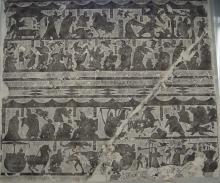Imagine having the opportunity to see, perhaps even touch, the ancient texts that have occupied your focus of study. The excitement in the voice of Seaver J. Milnor, a graduate student in Chinese linguistics, as he discusses his experiences as an intern at the Seattle Asian Art Museum attests to the success of this program. Thanks to a program funded by the Blakemore Foundation and administered by UW’s School of Art, graduate students in Chinese language and literature have had the opportunity to help prepare ancient Chinese artwork for exhibition.
Most recently, Milnor provided assistance for the current exhibitions of 2nd century shrine rubbings from Shandong Province and 18th century stone carvings of the sixteen Arhats. The rubbings were made in the 1920s and ‘30s from images in the Wu Liang Shrine (ca. 150 AD) on “rice paper.” In preparation for the exhibition, Milnor researched the images in order to create exhibition labels. “Researching the stories from early Chinese history and literature that have been depicted on the walls of the shrine was a highlight of the internship experience. It was also very rewarding to become an expert on the subject and help train the docents for giving tours of the exhibit,” Milnor says.
In addition to his contribution to the exhibition, Milnor has helped Curator Josh Yiu edit a book called Writing Modern Chinese Art: Historiographic Explorations, which was developed from a symposium on twentieth-century Chinese painting organized by Yiu in June 2007. Using Qing dynasty documents, Milnor also made a list of snuff bottles produced during the reign of the Yongzheng Emperor (1720s).
Milnor is the second AL&L student awarded this honor. In 2007-08 year, Mark Pitner also interned at the museum. He says, “The experience has profoundly changed how I view my work both in the details and directions of my research but also how I view scholarship, at the core of which is an appreciation of and hands on experience in doing accurate and detailed research that is both useful to the research community but also accessible to the broader public.”
Photo by Seaver Milnor with the permission of the Seattle Art Museum.
